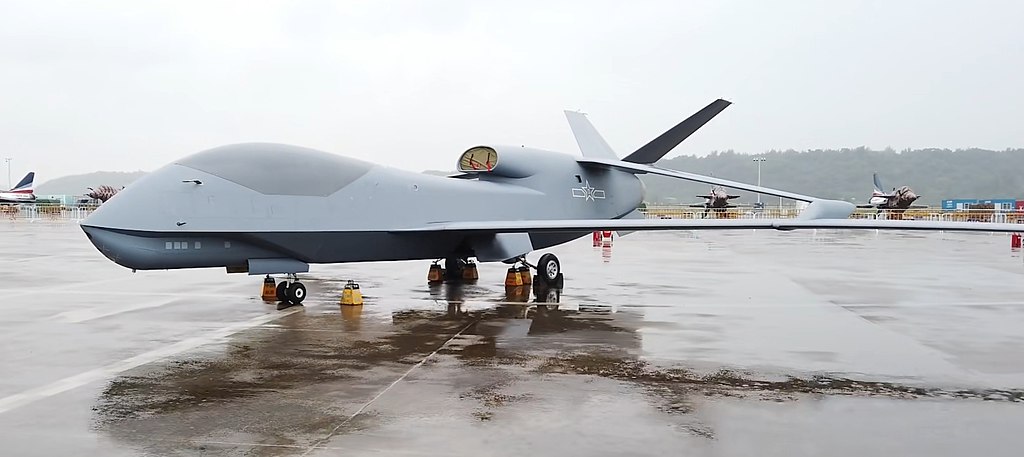
China’s WZ-7 (“Soaring Dragon”) is a high-altitude, long-endurance drone, shown here
on display during the 2022 Zhuhai Airshow.
“With its inherent advantages of having a world-leading industrial system and strong production capacity, China already has an absolute advantage in the Sino-US arms race around UAVs, loitering munitions, and cruise missiles.”
China claims its new turbofan could give it an edge during a high-intensity war. According to the first article posted on the publicly owned Chinese Internet platform Tencent, the Institute of Engineering Thermophysics of the Chinese Academy of Sciences has developed a new-generation, low-cost, easy-to-manufacture turbofan engine, which can be used in high-speed, long-endurance unmanned aerial vehicle (UAV) and missiles. A turbofan engine, first conceptualized in the 1930s is also known as a fanjet, is a modern variant of the gas turbine engine.
What makes the recent Chinese version unique is that it has a significantly reduced number of parts. According to the second article, published by leading Chinese Internet and gaming provider NetEase, there are only two stages, a fan stage and a high-pressure compressor stage. In contrast, according to the article, the U.S. Global Hawk’s turbofan engine has 13 additional stages. This less complex structure makes it 20 to 30 percent lighter and less expensive to manufacture than other turbofans. The first article argues that these simpler turbofan engines will allow China to produce them faster and increase “the operational efficiency of frontline combat forces.” For example, the People’s Liberation Army will be able to turn to private enterprise with lower technical capabilities than specialized military industrial complex to manufacture the new variant. Noting lessons learned from the Ukraine conflict, the article argues that “the side able to dominate the battlefield is often not the Ukrainian military with its advanced NATO equipment, but the Russian military, which can steadily supply less advanced equipment to the frontlines.” The article also notes that by leveraging its cost and production capacity to provide a continuous supply of units to power its weapons, China can ensure that “when a conflict does break out between [it] and the United States,” the U.S. military will not be able to “engage in a high-intensity war of attrition.”
Sources:
Jiang Fuwei, “中美无人机军备竞赛,中国抢先立于不败之地,可以让美军更清醒 (In Sino-U.S. UAV Arms Race, China’s Advanced, Invincible Position Can Make the U.S. Military Sober Up),” Tencent (a major Chinese platform company that connects users, businesses, and industries with technology and innovation, 1 November 2023. https://new.qq.com/rain/a/20231101A03WF100
“Zhu Junqiang, director of the Institute of Engineering Thermophysics of the Chinese Academy of Sciences, said that they have developed a new-generation low-cost turbofan engine, and this new engine has been used in a certain type of high-speed, long-endurance UAV.
This type of turbofan engine reportedly adopts a very unusual single-shaft high-pressure direct-drive configuration, which integrates the compressor and fan that must be arranged separately in conventional twin-shaft engines, reducing the number of engine parts by more than 60 percent. This reduces the overall weight and size of this type of engine by 20 to 30 percent compared to conventional twin-shaft configuration engines with the same thrust, and it also reduces fuel consumption by 10 percent.
In other words, the emergence of this type of engine not only signifies that the performance of domestic UAVs, loitering munitions, and even cruise missiles using turbofan engines will be significantly improved, but also that the manufacturing costs of these types of equipment will be further reduced to what can be called a “formidable” level. With its inherent advantages of having a world-leading industrial system and strong production capacity, China already has an absolute advantage in the Sino-US arms race around UAVs, loitering munitions, and cruise missiles…
Once China can produce a new turbofan engine, which costs only 20 percent of that of the existing turbofan engine, even if [the engine] currently can only be used in weapons such as UAVs and cruise missiles, significantly reducing the overall cost can increase the output and equipment quantity of these weapons systems, thereby increasing the operational efficiency of frontline combat forces…
Due to the significant reduction in the number of parts, the degree of difficulty in producing this type of engine is greatly reduced…
Looking at the experience of the Russia-Ukraine conflict, the side able to dominate the battlefield is often not the Ukrainian military with its advanced NATO equipment, but the Russian military, which can steadily supply less advanced equipment to the frontlines.
At this point, once the PLA can leverage these advantages in cost and production capacity, it can establish strong anti-loss capabilities and continuous supply capabilities for weapons such as UAVs and cruise missiles.
So, when a conflict does break out between China and the United States, the US military in the Western Pacific will not have the ability to engage in a high-intensity war of attrition with the PLA….
Jianduan Fangu, “我国研制成功高空低油耗涡扇发动机,战略无人机将傲视全球 (My Country Has Developed a Successful High-Altitude, Low-Fuel-Consumption Turbofan Engine and Will Dominate the World of Strategic Drones),” NetEase, (A leading Chinese Internet and gaming provider centered around premium content.), 26 October 2023. https://www.163.com/dy/article/IHVD86H205565PRU.html
The Institute of Engineering Thermophysics of the Chinese Academy of Science developed a high-performance, high-altitude, low-fuel-consumption turbofan engine, with greatly improved technology… First, the Institute of Engineering Thermophysics’ high-altitude, low-fuel-consumption turbofan engine has greatly simplified the engine structure. There is only one stage for the fan and one stage for the high-pressure compressor. The first stage uses a diagonal flow compressor, and the second stage uses a centrifugal compressor. The pressure ratio of each stage is very high, which significantly reduces the number of compressor stages. Comparing it to the Global Hawk’s engine, there are 13 fewer stages, which greatly reduces the number of parts. This reduces the complexity of the engine, which reduces fuel consumption and makes it cheaper.
Image Information:
Image: China’s WZ-7 [R1] (“Soaring Dragon”) is a high-altitude, long-endurance drone, shown here on display during the 2022 Zhuhai Airshow.
Source: https://commons.wikimedia.org/wiki/File:WZ-7_at_Airshow_China_Zhuhai_2022.jpg
Attribution: CCA-Share Alike 4.0 Int
